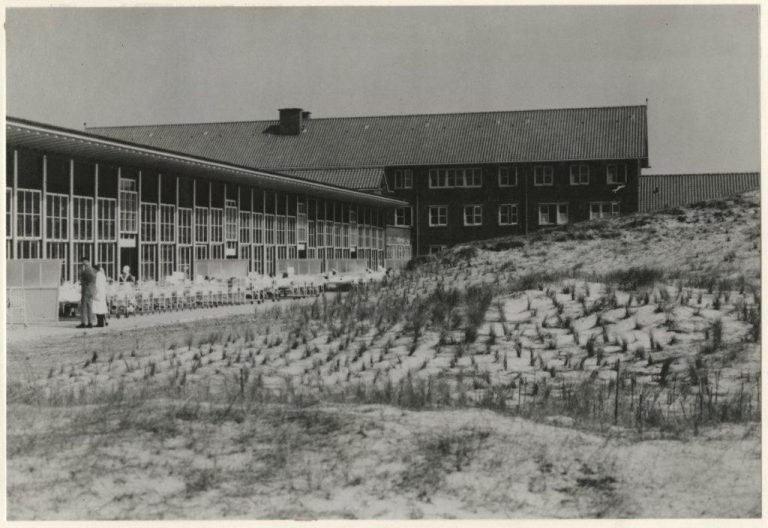In the winter of 1975-1976 I spent a few weeks in a building with a sea view. No, I did not sleep in one of the seaside hotels at the time, but in the Zeehospitium, which was then still located on Kijkduin. The Zeehospitium was a rehabilitation clinic with departments of orthopaedics and rheumatism. I was admitted there because I was suffering from rheumatic fever (which I am completely cured of!).
Sea bath facility for the needy
The original predecessor of the Zeehospitium was the “Sea bath facility for the needy of The Hague”. In the 19th century it was discovered that sea air and sea water were good for health. Jacobus van der Mandele, a doctor from Scheveningen, believed that sick children from poor families, as well as those of better-off parents, should be able to enjoy these benefits. His goal was realized in 1875, when, after the mediation of the Hague Red Cross, a barrack with space for 15 beds was built in the Dunes near the Harstenhoekweg. The demand was great: within two years, applications for admission had risen to 49, and tents were set up to accommodate the additional patients.
A queen dies
On 4 June 1877 Queen Sophie, the wife of King Willem III, died at Huis ten Bosch. She had always shown a great interest in charity, something the Dutch had greatly appreciated in her. Within two days after her death a group of citizens made an appeal in the newspaper to erect a statue for her.
Another group of citizens thought the establishment of a children’s hospital in her name would be more appropriate. This group wanted to raise money for the extension of the Diaconessenhuis in The Hague. But a diaconessenhuis is a Protestant institution; a children’s hospital there would exclude people of other denominations or faiths. So this memorial to Queen Sophie needed to be a “general” hospital for children.
A committee
In accordance with good Dutch practice, a committee was set up to determine how to make this hospital a reality.
In May 1878 this committee received a letter from the board of the “Sea bath facility for the needy of The Hague” (see above). The letter proposed that the committee and the board work together to create a children’s hospital for the summer months. This seemed like a good plan, so the search for a good location began.
Location
All kinds of places were considered but rejected: too close to the military shooting range in the dunes (a bit risky with small children), too close to the municipal bathhouse where the posh visitors had their daily bath (“if those TB children go into the sea, we will no longer go”).
Ultimately, the choice fell on a piece of land between the village of Scheveningen and the bath house. That spot was diagonally opposite the villa of Prince Frederik, the uncle of King Willem III and a great admirer of Queen Sophie. (In the death portrait of Queen Sophie you can see his bust on the right side of the chimney.) This prince did not mind having sick children as neighbours and even donated NLG 20,000 for the purchase of the land. Prince Alexander, Sophie’s youngest son, added another NLG 5,000.
On 17 June 1880 both princes were present at the opening of the first Zeehospitium of the Sophia Foundation with 100 beds at Gevers Deynootweg 21 in Scheveningen.
The second Zeehospitium
Over time, the area around the building became more built-up, to the extent that the original concept of a stay by the sea got lost. Therefore it was decided to build a new hospital at Hoek van Hollandlaan in Kijkduin. Construction started in April 1939 and the official opening was on 29 November 1940.
Meanwhile World War II had broken out and our country had been occupied since 10 May 1940. This had far-reaching consequences for the Zeehospitium. On May 15, 1942, the sanatorium management of the German Ortskommandant was ordered to evacuate the patients and the building within two days. In January 1943, the brand new building was demolished to make way for the bunkers of the Atlantik Wall.
For the rest of the war, patients from the Zeehospitium (since the 1930s both children and adults) had to reside in temporary buildings. After the liberation they returned to Scheveningen, where three Swedish barracks were erected at Doorniksestraat.
The third Zeehospitium
In the meantime, there had been lengthy consultations with the National Government about rebuilding the Zeehospitium in Kijkduin. After eight years of discussions and negotiations, construction of the Third Zeehospitium began in 1954, on the old foundations of the second sanatorium. Queen Juliana held the official opening in Kijkduin on May 8, 1957. Footage of the opening.
In 1995, the Third Zeehospitium, having earlier been abandoned due to dune erosion that threatened to collapse the building, was demolished.
Today
The work of the Sophia Foundation is now carried out by an organization called Basalt. Since 2019, this has been the largest centre of expertise for specialist medical rehabilitation care in the Netherlands.
The building of the Sophia Foundation at Gevers Deynootweg still exists, now containing apartments. I show you this building during my bike tour “From city to sea”.










